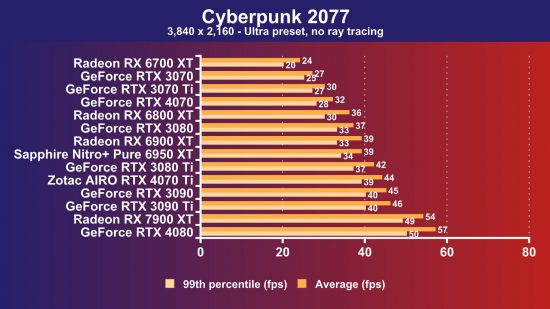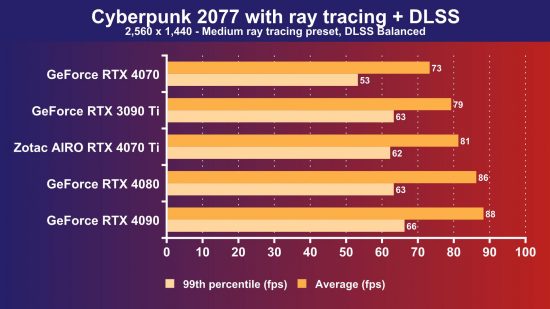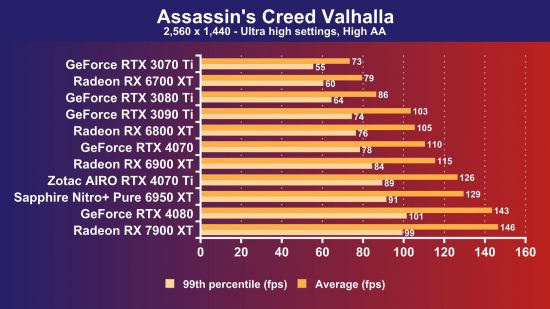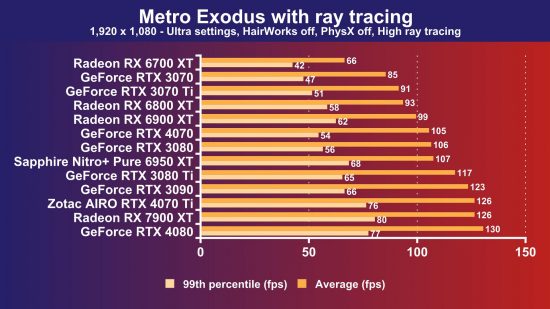Our Verdict
80%With fantastic 1440p gaming performance, DLSS 3 support, and a price that isn't completely ridiculous, the GeForce RTX 4070 is the new mid-range GPU king.
The Nvidia GeForce RTX 4070 has finally been unleashed onto the PC gaming public, and this mid-range gaming GPU has already started making waves with its $599 price and DLSS 3 support. While this price is higher than that of previous RTX 70-series GPUs at launch, after the last couple of years of chaos it’s refreshing to see a new GPU arriving with a price that isn’t completely inaccessible.
We have questions, though. Can the RTX 4070 cope with the demands of the new Cyberpunk 2077 Overdrive mode? How does the RTX 4070 compete with last-gen AMD Radeon RDNA2 cards, such as the Radeon RX 6950 XT, which are now going for similar prices?
To help us answer these questions and more, we were sent an Asus Dual GeForce RTX 4070 card for review, which has the same retail price and core spec as the RTX 4070 Founders Edition, while also only needing a single 8-pin PCIe power connector.
At Custom PC, we’ve been reviewing the latest gaming GPUs since 2003, and we run a number of grueling benchmarks in order to gauge performance. Our game tests include measuring the frame rate in Cyberpunk 2077, Doom Eternal, and Metro Exodus, all with and without ray tracing, and we also test with Assassin’s Creed Valhalla. For more information, see our How we test page.
Built using the same Ada Lovelace architecture as the mighty GeForce RTX 4090, the 4070 supports Nvidia’s DLSS 3 AI frame generation technology to speed up frame rates, and promises vastly improved ray tracing performance over equivalent GPUs from previous generations.
The new GPU is based on the same 295mm² AD104 chip as Nvidia’s GeForce RTX 4070 Ti, but with 14 fewer streaming multiprocessors (SMs) enabled, meaning it’s less powerful than the RTX 4070 Ti, but should still be potent when it comes to frame rates in games.

Each SM contains a single 3rd-gen RT core for real-time ray tracing in games, making for a total of 46. You’ll also find 128 CUDA cores in each SM, meaning you get a grand total of 5,888 CUDA cores in the GeForce RTX 4070. The new GPU also contains 184 4th-gen Tensor cores, which Nvidia uses in its DLSS resolution scaling tech.
As a point of comparison, the RTX 4070 Ti has 60 SMs enabled, giving it 7,680 CUDA cores – that’s a 23 percent drop in parallel processing power, so we’re expecting to see a significant performance gap between the two GPUs.
The RTX 4070 also has slightly slower clock speeds than the Ti variant, with Nvidia quoting a max boost clock of 2475 MHz for the RTX 4070, compared with 2610 MHz for the 4070 Ti. However, these figures are largely nominal – in our testing, the Asus Dual GeForce RTX 4070 boosted up to a maximum frequency of 2805 MHz, and it regularly hovered at around the 2730 MHz mark.
As with Nvidia’s other Ada RTX 4000-series GPUs, the RTX 4070 hooks up to a 16-pin PCIe 5 power cable, which you’ll need to make sure is firmly connected. Cards will also come with an adaptor that takes two standard 8-pin PCIe power plugs, and models, including the Asus GeForce RTX 4070 Dual card we’re testing, have just one 8-pin PCIe power cable. Nvidia recommends using at least a 650 W power supply with the RTX 4070.

Is 12 GB of memory enough?
Like the RTX 4070 Ti, GeForce RTX 4070 cards are also equipped with 12 GB of GDDR6X memory running at 1313 MHz (21 GHz effective), which is connected through a 192-bit memory interface, giving you a total memory bandwidth of 504 GB/s.
AMD has already come out fighting, claiming that 12 GB of graphics memory is not enough in some circumstances. We monitored the VRAM usage during our testing and found that there’s largely nothing to worry about if you’re running today’s games at 1,920 x 1,080 or 2,560 x 1,440 with 12GB of VRAM.

However, running games at 4K starts to push the boundaries in some games. Both Assassin’s Creed Valhalla and Metro Exodus were well below the threshold to cause any worries, but Doom Eternal with ray tracing at 4K with Ultra Nightmare settings (settings with which the RTX 4070 provides playable frame rates) used around 10.5 GB of VRAM.
Running Cyberpunk 2077 at 4K with DLSS 3 and Ultra ray tracing saw the VRAM usage hit 11.8 GB, and enabling Overdrive mode at 4K resulted in the memory being maxed out and frame rates constantly stalling. In short, 12 GB is going to be fine for running today’s games at this GPU’s target resolution of 2,560 x 1,440, but it’s on the edge when you hit 4K, and it doesn’t leave much headroom if future games are more demanding on memory.

The Asus Dual GeForce RTX 4070
There’s historically been a bit of a disparity between the price of Founders Edition cards and those from board partners, but Asus has made a concerted effort to hit the $599 MSRP with its Dual GeForce RTX 4070 card.
There are no RGB bells and whistles, but it’s a well-made card that covers all the basics. There’s a backplate on the rear of the card, and its twin axial fans did a great job of cooling temperatures in check without making any annoying noise (plus the fans don’t spin up when the card is idle). The GPU temperature peaked at 63.9°C during game testing, with a hot spot of 75.8°C, which is perfectly fine.

Despite its lack of frills, it’s also a good-looking, minimalist card. Its translucent top gives you a view into the heatsink fins, and the curvy black shroud neatly encases the PCB. Unlike the RTX 4070 Founders Edition, the Asus Dual card cuts into a third expansion slot space, rather than neatly slotting into two slots, but it’s still quite compact, measuring 267 mm long.
One feature we also really like is the single 8-pin PCIe power connector, rather than relying on a 16-pin PCIe 5 connector and an adaptor. This means you can easily swap out your existing graphics card for this one without having to reroute any cables, and you can also rest easy that a wobbly connection isn’t going to end up with a cooked graphics card.

RTX 4070 Cyberpunk 2077 frame rate
The GeForce RTX 4070 is ideal for running Cyberpunk 2077 at 2,560 x 1,440, with very similar performance to the last-gen GeForce RTX 3080. If you’re happy to run it without ray tracing and DLSS, it produces an average frame rate of 71 fps with a 56 fps 99th percentile result, which is smoothly playable.
Add Medium ray tracing to the mix and the average frame rate drops to a clunky 42 fps, but this is still 10 fps quicker than the Radeon RX 6950 XT, and you can also get a helping hand from DLSS. With DLSS set to Balanced and ray tracing set to Medium, that average frame rate at 2,560 x 1,440 increases to 73 fps, with a 53 fps 99th percentile result.
Even setting ray tracing to Ultra and DLSS to Quality doesn’t kill performance, with a half-reasonable average frame rate of 58 fps and 99th percentile result of 46 fps.
Of course, where the RTX 4070 really gets a helping hand, and where the AMD GPUs can’t compete, is when you enable Nvidia’s DLSS 3 AI frame generation tech. Even at 4K, if you enable DLSS 3 at the Ultra ray tracing preset and the RTX 4070 produces an average frame rate of 65 fps, with a 55 fps 99th percentile result.
Amazingly, this $599 GPU can just about cope with the demands of the new Cyberpunk 2077 Overdrive mode if you enable DLSS 3 and set standard DLSS (Super Resolution) to Quality. At these settings, the average frame rate of 52 fps and 99th percentile result of 45 fps make for a surprisingly playable experience. Drop the resolution to 1,920 x 1,080 and you can run Overdrive mode at an average of 86 fps at the same settings.
However, bear in mind that while DLSS 3 does an amazing job of boosting frame rates with amazing visual settings, it doesn’t always work perfectly. We saw occasional artifacts in our custom benchmark, based on a 60-second repeatable drive around Night City, including a line consistently appearing in a wall at the start.
RTX 4070 Assassin’s Creed Valhalla frame rate
Previously an AMD stronghold, Assassin’s Creed Valhalla runs great on the GeForce RTX 4070. At Ultra high settings, and with the field of view set to 100 percent, the RTX 4070 even makes the game playable at 4K, with an average frame rate of 63 fps, and 99th percentile result of 47 fps.
Run it at 2,560 x 1,440, and the average frame rate increases to 110 fps, while the 1,920 x 1,080 average frame rate hits 140 fps. These are great results, but the last-gen Radeon RX 6950 XT is significantly quicker in this game, and it doesn’t cost much more money.
RTX 4070 Doom Eternal frame rate
The GeForce RTX 4070 frame rates in Doom Eternal are phenomenally good for the price. At 2,560 x 1,440 the RTX 4070 average frame rate is 370 fps, with a 246 fps 99th percentile result – more than fast enough to make the most of a monitor with a fast refresh rate.
You can also happily enable ray tracing in this game and still hit an average frame rate of 249 fps, without any need to enable DLSS. Even at 4K with ray tracing you’re looking at an average frame rate of 133 fps and a 99th percentile result of 86 fps. Comparatively, the Radeon RX 6950 XT drops down to a 68 fps 99th percentile result at these settings, with a 103 fps average.
RTX 4070 Metro Exodus frame rate
The GeForce RTX 4070 copes well in Metro Exodus, with very similar performance to the GeForce RTX 3080. If you’re running the game without ray tracing or DLSS, the average frame rate of 100 fps at 2,560 x 1,440 is great, though the Radeon RX 6950 XT clocks up 120 fps here.
The RTX 4070 struggles a little with these settings at 4K, though, with the 99th percentile result dropping to 40 fps and average frame rate falling to 64 fps. This is an area where the extra shader power of the Radeon RX 6950 XT is demonstrated, with a stronger 99th percentile result of 50 fps and average frame rate of 76 fps.
The gap between the two GPUs closes when you enable ray tracing in Metro Exodus, though. At 2,560 x 1,440 with High ray tracing, the GeForce RTX 4070’s average frame rate is 79 fps, with a 46 fps 99th percentile result, which is fine, and that’s without any help from DLSS either. The RTX 4070 struggled with these settings at 4K, though – only the RTX 4080 and 4090 can really cope with these settings.
Nvidia GeForce RTX 4070 power draw
Nvidia has made great strides when it comes to performance per Watt with the Ada architecture, with our GeForce RTX 4070 having a power draw of just 369 W. This is nearly 100 W less than with the RTX 3070 Ti fitted, and 27 W less than with the GeForce RTX 3070.
Comparatively, our system drew 494 W with the RTX 3080 installed – that’s 125 W more than the RTX 4070 for very similar performance. You can also see a disadvantage of buying a last-gen Radeon RX 6950 XT in these results – it might have faster rasterization performance, but our system drew 558 W from the mains with the Sapphire Nitro+ Pure Radeon RX 6950 XT installed.

Nvidia GeForce RTX 4070 pros and cons
Pros
- Fantastic 1440p performance
- DLSS 3 support
- Low power draw
Cons
- Still a bit overpriced
- Radeon RX 6950 XT faster at rasterization
- Only 12 GB of memory
Nvidia GeForce RTX 4070 specs
The Nvidia GeForce RTX 4070 specs list is:
| Stream processors / CUDA cores | 5,888 |
| RT cores | 46 (3rd-gen) |
| Tensor cores | 184 (4th-gen) |
| ROPs | 64 |
| Base clock | 1920 MHz |
| Max boost clock | 2475 MHz |
| Memory | 12 GB GDDR6X |
| Memory clock | 1313 MHz (21 GHz effective) |
| Memory bandwidth | 504 GB/s |
| Memory interface | 192-bit |
| Card interface | 16x PCIe 4 |
| Power connectors | 1 x 16-pin / 2 x 8-pin / 1 x 8-pin |
Nvidia GeForce RTX 4070 price
The price of the RTX 4070 is much lower than that of previous RTX 4000-series cards, but still high compared to previous-generation GPUs. In the current market, it’s a reasonable price for the performance on offer.
Price: $599 (£589)
Nvidia GeForce RTX 4070 review conclusion
Welcome back to normality, Nvidia. The GeForce RTX 4070 delivers fantastic performance across the board at 2,560 x 1,440, and it’s amazingly power-efficient too. In particular, its ray tracing frame rates are superb, and its support for DLSS 3 really gives it an edge in highly demanding games. Enable this AI frame-generation tech and you can even run Cyberpunk 2077 in its new Overdrive mode.
It’s not a clean win, though. While the RTX 4070 is much cheaper than previous Ada GPUs, its price is still $100 higher than the RTX 3070’s launch price. In terms of raw rasterization performance, the Radeon RX 6950 XT is also more powerful, and these cards currently go for around $640, which is in the same ballpark as the RTX 4070’s price. In addition, the 6950 XT comes with 16 GB of memory, compared with just 12 GB on the RTX 4070.
However, even with those caveats, we’d still recommend the RTX 4070 as the best mid-range GPU right now. It offers a better all-round experience at 2,560 x 1,440, with great ray tracing performance, low power draw and a significant helping hand from DLSS 3 in games that support it.
If you’re looking for a mid-range gaming GPU, the GeForce RTX 4070 is the new king of the castle, and this Asus Dual model is a great example – it’s quiet, good-looking, well-priced and only needs a single 8-pin PCIe power connector.
Are you tempted to jump on Nvidia’s Ada bandwagon now? Let us know your thoughts and questions on this post by joining the conversation on the Custom PC Facebook page, via Twitter, or join our Custom PC and Gaming Setup Facebook group and tap into the knowledge of our 350,000+ members. You can also find more graphics card recommendations in our best graphics card guide.
























































